Is your current gym routine boring you? Do you need a pick-me-up for your body and mind? Well, kickboxing might be the answer! It’s a great exercise that doesn’t use weights or machines but instead relies on skillful movement to give you a full-body burn. You won’t even realize how many calories you’ll shred between the fun and fast paced routines that make the time fly by. It’s a sport that can be done in a group, in pairs, or alone.
But maybe, like many women, you only know about kickboxing from movies that portray it is as a full-contact and competitive male-dominated sport. Don’t worry, we are going to debunk the misconceptions about this together. Most importantly, it’s great to remember that it can actually be practiced in a non-violent, purely cardio-based form as well. Plus, it’s 100 percent made for women just as much as men, so don’t get intimidated!
On top of that, this sport has some pretty kickass health benefits too. So stick with us to learn more about what exactly kickboxing is, coupled with an easy routine to get you started and some tips for practicing!
What Is Kickboxing?
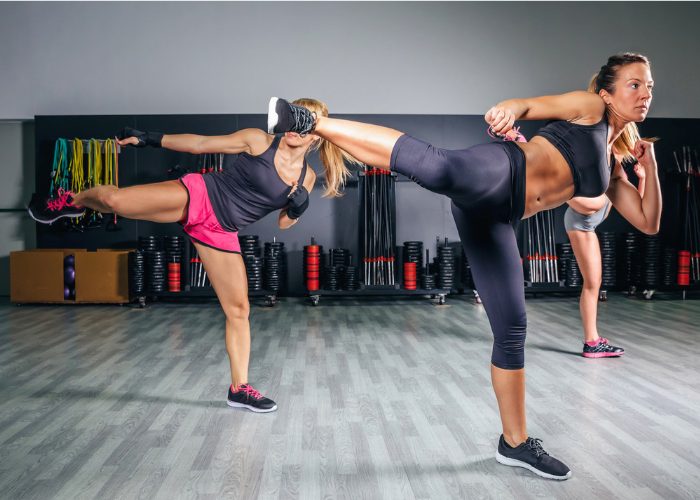
The origins of kickboxing can be traced back to Japan from their many forms of martial arts. There are many different styles of kickboxing and as you advance in your practice, you’ll be able to find one that suits you the most.
No matter the style, think of it like a dance. Your arms and legs are flowing out and back in, using the space around you. You can dance alone or with a partner, and it’s a — dare we say — graceful artform that can get your blood flowing. Let’s take a look at the different forms of kickboxing and see which one might be the best fit for you.
Common types of kickboxing
Whether you want to spar with an opponent or practice at home with a YouTube instructor, there’s a kickboxing style for you. Here are just a few examples of the most common forms.
Muay Thai
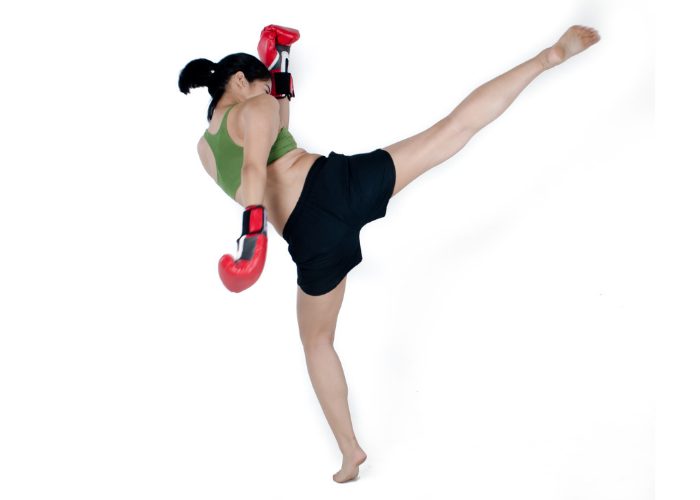
Muay Thai translates to “Thai boxing”. While this sport falls into the category of kickboxing, it’s a generally more difficult and skillful artform. Instead of using only hands and feet, Muay Thai fighters can also use their elbows and knees, giving them up to eight contact points to fight with. It’s an amazing form of self-defense and will leave you feeling empowered. Additionally, this form of kickboxing is great for fitness and weight loss. A Muay Thai boxing gym concluded that you can burn over 800 calories in one hour of boxing in the ring.[1]
Tae Bo

This hybrid form of martial arts is one of the newest forms of kickboxing, combining mostly taekwondo, boxing, and choreography. It was created specifically as a single person aerobic workout and not as a contact sport. Similarly to CrossFit, it’s pretty high intensity. However, Tae Bo is less about form and more about fast movement and cardio. A 150-pound person can burn about 687 calories in a one hour Tae Bo class.[2]
American Kickboxing

This type of kickboxing is typically a contact sport (unless practicing alone), and consists of high kicks and punches. Unlike Muay Thai, using elbows or knees is not allowed for safety reasons. It’s a pretty even mix between traditional boxing and karate. You can usually find hanging punching bags at the gym that are ideal to practice with if you want to get a feel for the contact aspect without sparring with an actual person just yet.
Fun Fact: Muay Thai is often referred to as the “art of eight limbs.” This is because it uses eight points of contact as opposed to four like in traditional boxing. Do you remember what the eight points of contact are? (Hint: the contact points come in pairs)
7 Benefits of Kickboxing That Will Make You Want to Start
So now you know what kickboxing is and the different styles of the sport that make it a fun and exciting way to get in shape. But what other benefits does this full-body blast have? Well, the answer includes both health benefits and psychological perks too.
1. Better heart health

Heart disease is the leading cause of death for women in the United States, killing 289,758 women in 2013 — that’s about 1 in every 4 female deaths.[3] Thankfully, the fast-paced, full-force hits and routines in kickboxing ensure that your heart will be getting a good workout.
One study showed the difference between a cardio workout on a treadmill and a non-contact kickboxing workout, such as Tae Bo cardio kickboxing. The results proved that kickboxing raises your heart rate more than a treadmill run of the same intensity.[4] So, it’s worth considering trading treadmill runs for kickboxing classes a few times a week for better heart health.
2. Burn body fat
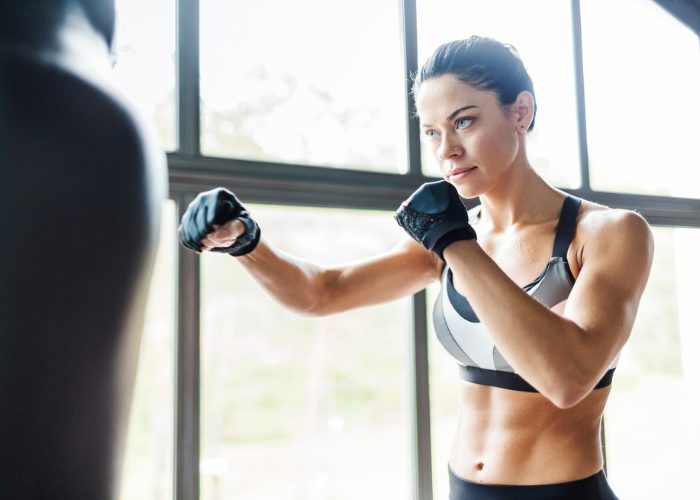
In a kickboxing class or training session, you’ll use pretty much all major muscle groups. You use your arms and back to throw forceful punches, your legs and glutes for front, side, and back kicks, and your abs for stability throughout.
After your first session, you might leave feeling muscles you didn’t even know you had. But that’s a good thing! Kickboxing has been proven to improve upper and lower-body muscle power, aerobic power, flexibility, speed and agility.[5] That burn might just turn into an addiction that will leave you wanting to go back for more.
3. Get self-defense skills
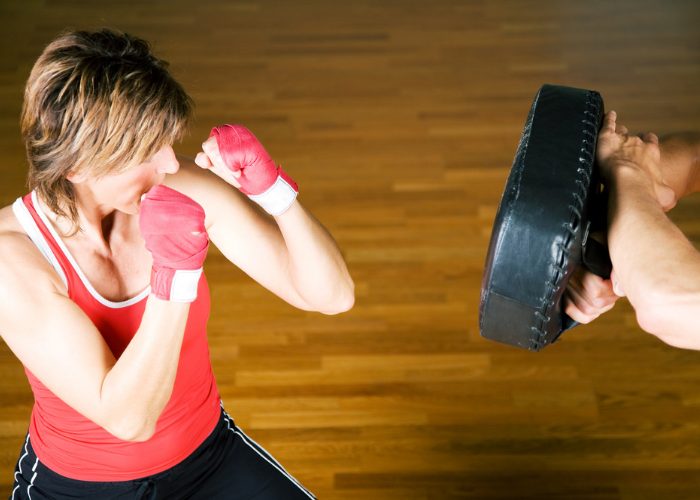
All the moves in martial arts, especially kickboxing, are great for self-defense. According to the National Intimate Partner and Sexual Violence Survey, one in three women in the U.S will experience some kind of contact sexual violence in their lifetime.[6]
This tragic statistic is a wakeup call for women to equip themselves with the confidence and ability to fight back. Through the moves learned in kickboxing, you can feel a little safer if an unfortunate situation arises. Some gyms even offer special kickboxing classes designed with self-defense in mind, where you learn moves and “grab points” if you’re being assaulted.
4. Feel empowered and confident
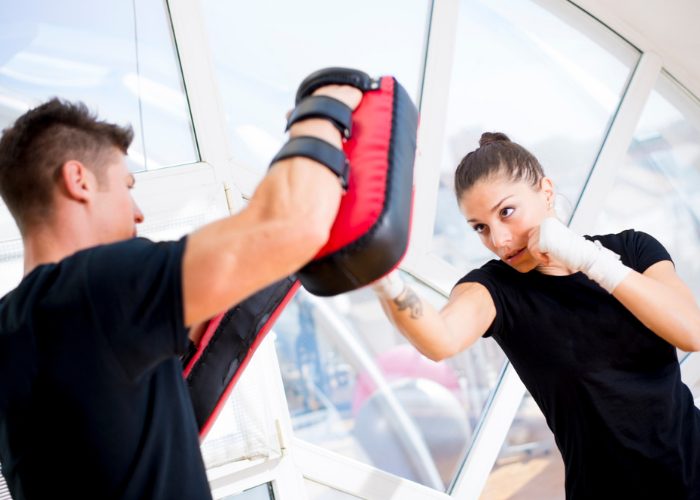
Martial arts is a powerful tool for women to feel confident and healthy. One study that tracked women in martial arts showed that they felt like they had increased ability to defend themselves and could challenge gender embodiment.[7]
You should already know that women can accomplish anything, but physical feats typically associated with men are even more fun to master as a female. Kickboxing combines powerful moves with force and flexibility, allowing you to see improvement that carries into your daily life. For some, gaining a sense of empowerment through sports can be just as valuable as the physical health benefits too.
5. Improve coordination and motor abilities
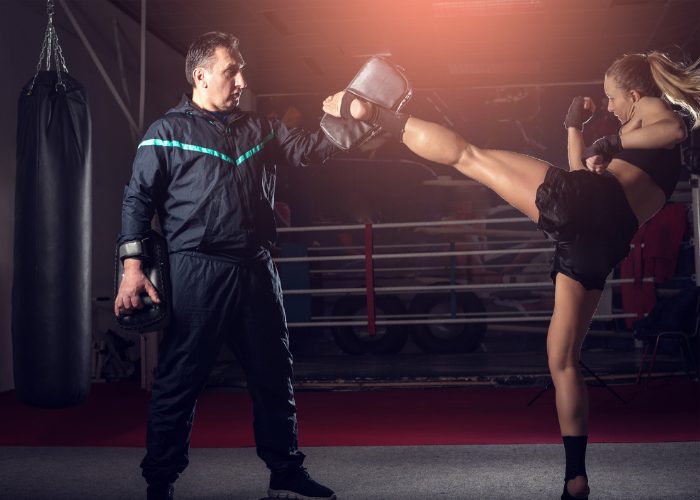
Studies show that martial arts (kickboxing specifically) can improve your motor abilities.[8] The main areas of coordination that kickboxing athletes utilize are:
These functions are all necessary for daily life. Kickboxing targets their use to stimulate and improve them. Patients with multiple sclerosis reported that their balance improved after a five-week kickboxing course.[10] Additionally, Parkinson’s patients also showed improvement in balance as well as quality of life after training.[11] So get to a class if you’re eager to improve your coordination or manage symptoms from a neuromuscular disease.
6. Benefits of a HIIT workout
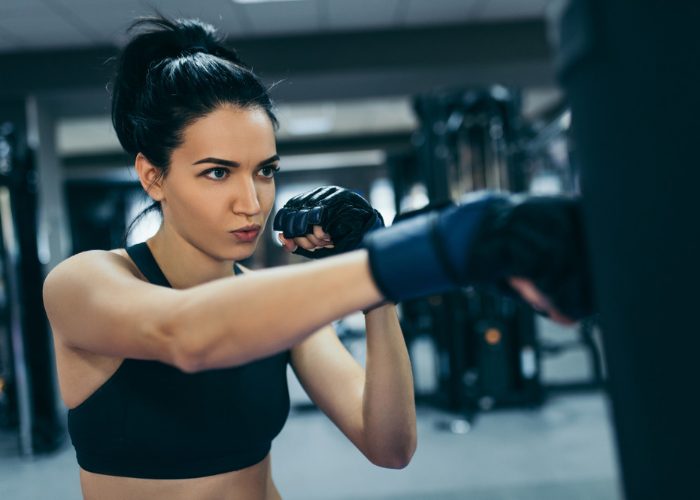
What do you normally do at the gym? Maybe you spend time on the elliptical, lift weights, or do a dance class. Kickboxing is sort of a combination of all three. It combines cardio, forceful power hits, plus body movement.
All these kickboxing moves are usually done in short bursts, similar to HIIT workouts (high intensity interval training). The combination of moves with the bursts of high cardio allow you to accomplish more in shorter time periods.[12] HIIT has been shown to improve blood pressure, fat content, and insulin action.[13] Raise your hand if you want these benefits from shorter, more engaging workouts. We certainly do!
7. Releases stress
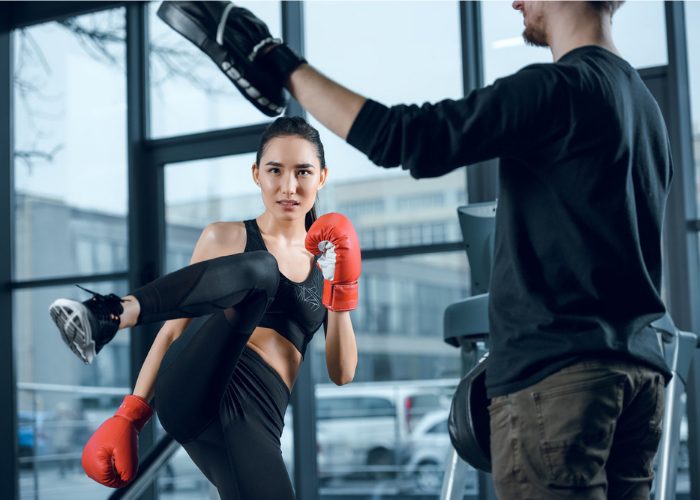
If you’re like most women, you’re juggling so many things throughout the day and even more in a week. Between work, friends, family, hobbies, and keeping a healthy lifestyle, things can get pretty hectic. It’s no wonder a work-life balance can seem impossible.
Consider kickboxing once or twice a week to release some of the stress in your mind and muscles that you might not even notice you are holding onto. According to one study, you’ll release even higher levels of stress when you work out in a group class.[14] Working out in a group increases your mental, physical, and emotional qualities of life. Compared with working out solo for twice as long, which only showed improvement in mental quality of life.[15] What are you waiting for?
Fun Fact: Billy Blanks is the original creator of Tae Bo, which took off in the 1990’s as a video fitness program. He is now 63 years old and still working out!
The Best Kickboxing Workout For Beginners
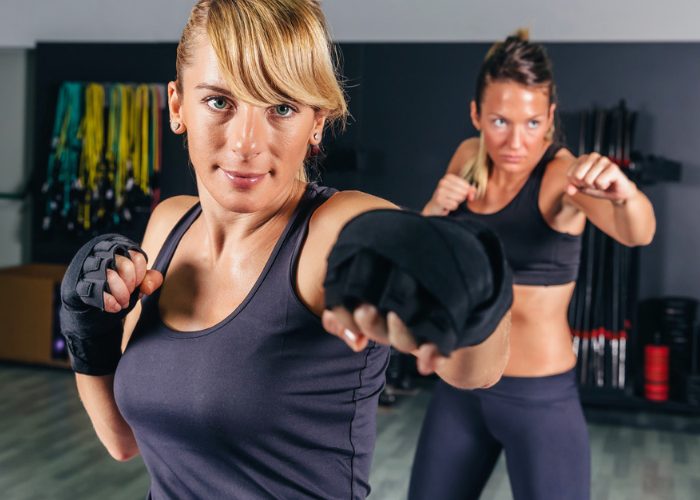
By now, kickboxing shouldn’t seem so scary after all. Hopefully its many potential health benefits will motivate you to try this beginners’ workout, which can be done anywhere you feel most confident and powerful.
All you need are some comfortable, non-constricting workout clothes (you want to feel like you can move freely). Even shoes are optional for this workout!
The following routine should be done repetitively for 30 minutes. After each round of the five exercises, switch sides so that your stance involves your non-dominant arm and leg in the back.
Pro Tip: Put on some music to jam out to while you work out! One study showed that music with a faster temp actually helps you exert more energy into your session as opposed to slower tempo music.[16] So don’t be shy with your beats!
1. Stance | All moves start and end here

How to do it
- Stand shoulder-width apart. Take a step back with your dominant leg. For example, if you’re right-handed, step back with your right leg (your dominant leg) so that your left shoulder is facing front.
- Hold your fists in front of your face to use for quick protection.
- Bend your knees slightly.
2. Jab | 4 reps

How to do it
- Get into your stance.
- Move your dominant hand forward in a punching motion, making sure to end with your knuckles straight and forward-facing.
- Keep your non-dominant hand close to your face.
- Rewind to end back up in your stance.
- Do 4 reps of this.
3. Hook | 4 reps

How to do it
- Start in your stance position.
- Make sure there is a 90-degree angle with your forearm and upper arm.
- Swing your dominant arm forward to punch. If you’re using a punching bag, make sure your first two knuckles are first to make contact.
- Pivot your dominant back leg with this move, engaging your core.
- End in your stance.
- Perform 4 reps.
4. Front Kick | 4 reps

How to do it
- Start by getting into your stance.
- Lift your dominant knee.
- Curl your toes back, as you want to make kick contact with the ball of your foot, not your toes.
- Extend out the rest of your leg forcefully, but be careful not to overextend. Your shins should be facing upwards during this kick.
- Bring back the leg in one motion to stance position.
- Repeat 4 times.
Remember: Keep both hands in a fist in front of your face at all times for protection and stability, even during kicks.
5. Side Kick | 4 reps
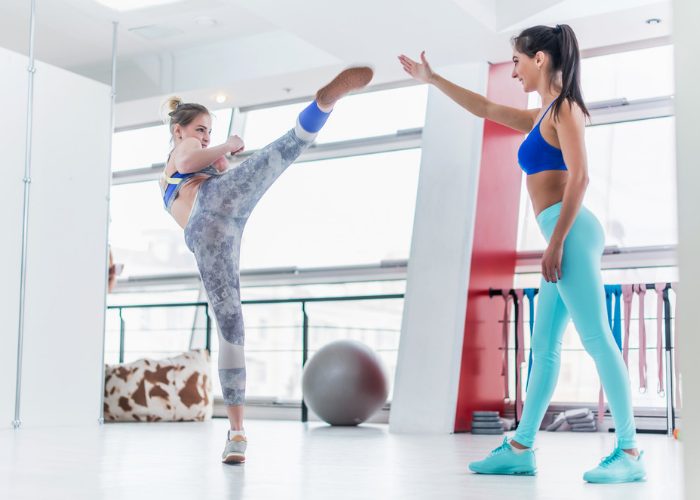
How to do it
- Begin with your stance.
- Put your weight on your back leg.
- Lift your non-dominant knee up.
- Extend the leg forward to kick while using your core to maintain stability and upright positioning. Your side hip should be facing upwards during this kick.
- Bring the leg down in one motion as you shift your weight forward to evenly distribute again.
Tip: It might help to learn on a wall or chair when you first practice this move as the balance can be tricky to master!
Andrea Taylor’s 10 Minute Kickboxing Workout [Video]
Kickboxing Near Me: How to Find the Best Classes & Other Expert Tips
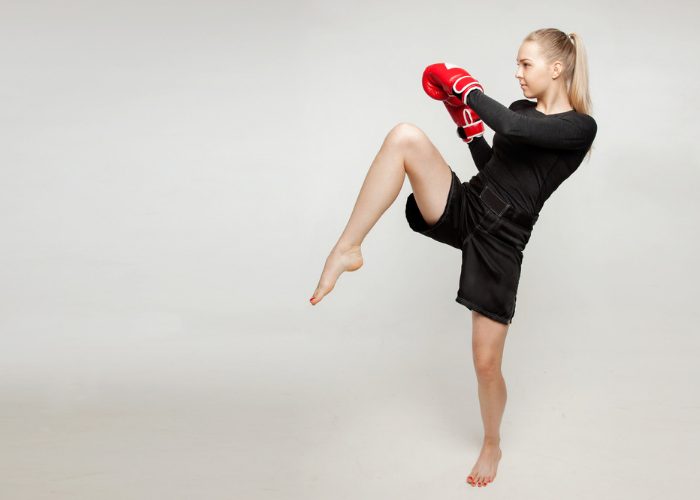
Want more from kickboxing than solo home-workouts? Try a kickboxing gym or group kickboxing classes. Follow these simple tips to find the perfect gym/class for you and practice there safely.
- Determine the style of kickboxing you’re interested in before you look. As there are various styles of kickboxing, it might be best to try a few at home first to see what’s your favorite. Try our beginner workout above, or dabble in some YouTube lessons to see what fits you. You could also look for a gym specifically for women’s kickboxing, which will no doubt be a fully empowering environment.
- Read online gym reviews. You’ll be able to read real accounts of other people ’s experiences to decide if a particular kickboxing gym is right for you. Some gyms even allow you to observe a class/training session before committing too (or even join a free trial). This way, you’ll know what you’re getting yourself into before you sign any contracts.
- Know what gear you ’ll need. If you want to attend more intense American kickboxing classes, you might need a pair of gloves or even a mouthguard. Alternatively, you might need nothing more than some workout clothes for a group Tae Bo class.
- Hydrate properly. Because kickboxing is an aerobic exercise, you’ll sweat a lot. It’s important to drink plenty of water in the hours before and after your workout so you don’t get fatigued.
- Stretch and remember good form. In kickboxing classes, you’re constantly shifting weight from your legs during kicks and stretching out your shoulders and arms. Stretching these muscles and warming up properly before you start is key to avoid injuries. It might even be worth getting a trainer to advise you on your form if your goal is to master self-defense or spar with other kickboxers.

Conclusion
The health benefits of kickboxing combined with the empowerment it brings makes this form of exercise a double win for women. It’s more than a just sport — it’s a mindful form of self-defense and full-body training. After hearing the truth about kickboxing, you should be prepared to make the leap into this practice or take your current training to the next level. So square up and get ready to transform your body and mind through kickboxing!
References
- [1] http://www.xmuaythaigym.com/heres-much-need-exercise-sit-day/
- [2] https://healthresearchfunding.org/tae-bo-calories-burned/
- [3] https://www.cdc.gov/dhdsp/data_statistics/fact_sheets/fs_women_heart.htm
- [4] https://www.researchgate.net/publication/48457296_Cardiovascular_and_metabolic_responses_to_noncontact_kickboxing_in_females
- [5] https://www.ncbi.nlm.nih.gov/pmc/articles/PMC4187584/
- [6] https://www.cdc.gov/violenceprevention/pdf/NISVS-StateReportBook.pdf
- [7] https://www.tandfonline.com/doi/abs/10.1080/02614367.2012.696128
- [8] https://www.ncbi.nlm.nih.gov/pmc/articles/PMC4187584/
- [9] http://www.johk.pl/files/06sadowski.pdf
- [10] https://www.ncbi.nlm.nih.gov/pubmed/22850333
- [11] https://academic.oup.com/ptj/article/91/1/132/2735142
- [12] https://journals.lww.com/nsca-jscr/Fulltext/2012/01000/Effect_of_High_Intensity_Interval_Training_on.18.aspx
- [13] https://journals.lww.com/nsca-jscr/Fulltext/2012/01000/Effect_of_High_Intensity_Interval_Training_on.18.aspx
- [14] https://www.sciencedaily.com/releases/2017/10/171030092917.htm
- [15] https://www.sciencedaily.com/releases/2017/10/171030092917.htm
- [16] http://jass.neuro.wisc.edu/2011/01/The%20Effect%20of%20Varying%20Musical%20Tempo%20on%20Exertion%20During%20Exercise%20in%20College%20Students.pdf








